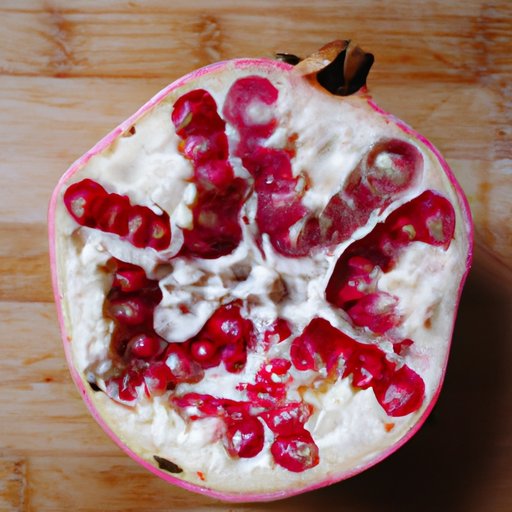
Introduction
When it comes to buying pomegranates, it can be hard to tell when they’re ripe and ready to eat. However, choosing the right fruit will make all the difference in flavor and nutrition. In this article, we’ll provide you with practical tips and expert advice on how to identify ripe pomegranates easily.
A step-by-step guide to identifying ripe pomegranates
It can be hard to tell when a pomegranate is ripe simply by looking at it. Here are some steps to ensure that you pick the best ones.
Step 1: Check the weight
A ripe pomegranate will feel heavy for its size and will be packed with juice. The weight is an excellent indicator that the fruit is matured and filled with juice.
Step 2: Look at the color
A ripe pomegranate will have a darker shade of red compared to unripe ones. A ripe pomegranate will also appear more vibrant, whereas an unripe pomegranate will appear dull and underdeveloped.
Step 3: Feel the firmness
A ripe pomegranate will feel firm and plump to the touch. It will be easy to hold and slightly yield to gentle pressure. Soft fruit could mean it is overripe and has lost quality.
Step 4: Check for cracks or blemishes
Avoid purchasing pomegranates if they have any cracks or blemishes on the skin. Blemishes or cracks are signs that the fruit is overripe and has likely lost nutritional value and might even be damaged inside.
Step 5: Bonus tip: Smell the fruit
A ripe pomegranate has a sweet, somewhat floral scent. A pomegranate that smells sour or unpleasant is likely past its prime.
Use visuals to show the difference between ripe and unripe pomegranates
Visuals can make complicated information more accessible, so let’s use images to make our point clearer.

Caption: A side-by-side comparison of ripe and unripe pomegranates. Notice how the ripe fruit has a deeper color than the unripe fruit.
Spot the signs of ripeness
Aside from the color, there are several other indicators of pomegranate ripeness.
Check the color (again, in more detail)
A pomegranate can be one of three colors: green, yellow, and red. When a pomegranate is growing, it’ll be green. As it matures, it turns yellow, then ultimately red. As we mentioned, the right shade is deep red-violet.
Listen for a metallic sound when tapped
When tapped, a ripe pomegranate will make a metallic sound, indicating that it is full of juice.
Feel for a slight give when squeezed (also discussed in more detail)
Gently squeeze the fruit with your fingers. It should be firm and plump, but it should also give a little. If the pomegranate feels hard like a rock, then it is not ripe yet.
Provide expert tips on identifying ripe pomegranates
We spoke with an expert on pomegranates, Mr. John, who has been growing and selling them for over a decade.
“Pomegranates need almost perfect growing conditions, but they’re worth the effort. The fruit is packed with antioxidants and vitamins, so it’s crucial to pick a good one,” says John. “If you’re looking to buy ripe pomegranates, make sure the fruit is heavy, and check for spots or soft areas. Also, look for the intensity of the color to make sure the fruit is fully mature.”
Share recipes using ripe pomegranates
If you’ve picked ripe pomegranates, you need to make something delicious with them.

Caption: A brilliant salad with arugula, pomegranates, figs, and goat cheese
Simple pomegranate salad
Combine cherry tomatoes and fresh arugula with a sprinkle of goat cheese and top it with fresh pomegranate for a delicious, an easy salad for your lunch or dinner time.
Pomegranate juice
In a blender, combine ripe pomegranate, sugar, and water, and blend until smooth. Strain the mixture to remove any solids, and enjoy your refreshing pomegranate juice for breakfast or any other time.
Conclusion
It can be challenging to determine if a pomegranate is ripe, but using these expert tips can increase your chances of picking out the perfect one. By paying attention to the color, texture, and weight, You will be able to pick the juiciest, sweetest, and most nutritious pomegranates every time. When you have ripe pomegranates, use them in your dishes to add flavors and bright colors.





